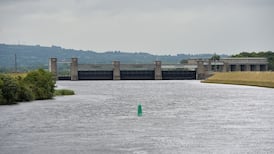Dublin Corporation is to attempt today to ease the traffic chaos which has been occurring at morning peak hours over a large area of south-west Co Dublin for the past 10 days. Trial restrictions introduced on Templeogue Road, which led to a build-up of traffic, are being lifted.
The corporation's director of traffic, Mr Owen Keegan, said peak hour "right-hand-turn bans" at Rathdown Park and Avenue off Templeogue Road, introduced after representations by local residents, were being lifted after consultation with the Garda.
He accepted that these had caused "major problems" over the past two weeks, and that motorists who had used these routes had encountered much longer travel times.
"We will be assessing the result of the trials before considering what future action to take."
Traffic calming measures may be introduced instead. Alternatively, the right-turn restrictions may be re-introduced once a quality bus corridor is in place along the major route through west Dublin into Terenure.
According to Mr Conor Faughnan of AA Roadwatch, what has become Dublin's worst traffic black spot arose since schools reopened.
The gridlock, however, was due to a series of factors. The closing-off of right-hand turns from Templeogue Road, which fed into Rathfarnham Road at peak morning times, was the trigger of unprecedented delays. This funnel led traffic through Terenure, which could not cope.
The worst effects were being felt in Knocklyon, Scholarstown, Fir house and Ballycullen. Another factor was that the completion of large housing estates had increased the huge volumes of traffic feeding into Firhouse Road. Motorists were facing long delays simply getting out of their residential areas.
Queues on Knocklyon Road meant it was taking up to 40 minutes to travel some 300 yards to traffic lights, and similarly on Ballycullen Road. "Commuters who were taking 30 minutes to get into town in the summer are now taking 40 minutes to get out of their estates."
The completion of the northern M50 section before the southern portion - it had been planned to construct the route the other way around - was attracting massive traffic volumes on to the M50 from the south through areas which could not cope. This was proving to be "immensely frustrating" for motorists, including those leaving the city for national primary routes to the south, west and north, or those coming off the M50.
The peak-time ban on turns at Rathdown Park and Avenue last week, and at Fergus Road two months ago, had compounded this problem.
New car sales so far this year total 126,429, a 16 per cent increase on the 1997 figure, said Mr Faughnan. He estimated that there are 1,000 more car-dependent households than three years ago in Knocklyon, an area with poor public transport.
There was little hope of any major improvement in the medium term, even with an easing of the Templeogue Road difficulties, as M50 work would soon exacerbate problems. Travelling to work earlier, car pooling and working "flexitime" offer some limited hope of reducing delays, he said.
Mr Frank Coffey, county engineer with South Dublin County Council, said the authority was looking at possible relieving measures with designers of the Southern Cross and the National Roads Authority. Construction work for the M50 and the lack of capacity at Balrothery interchange were causing the main problem in Firhouse.
The Fine Gael spokeswoman on Dublin traffic, Ms Olivia Mitchell TD, said emergency relieving measures were imperative. Appalling conditions for residents would continue until infrastructural projects were completed. But these could be eased by emergency measures including a temporary Bailey bridge over the Dodder river.
"Each morning huge volumes of traffic approach the Templeogue Bridge `pinch point' from the Ballyroan, Knocklyon and Fir house Roads . . .
"A temporary bridge between Firhouse and Templeogue bridges would allow traffic heading for the M50 to avoid the Templeogue bridge bottleneck", she argued.
Supt Tom Conway of Tallaght Garda Station said the problems boiled down to traffic volumes and a large number of arteries feeding into the M50.
Traffic from Bray, taking in Sandyford, Rathfarnham and Scholarstown, was feeding into the area, causing most difficulty at Firhouse. The gardai were attempting to help by manning junctions there but "we are damned if we do and damned if we don't," he said.
Assisting traffic in the immediate area was causing back-ups in Templeogue and in Tallaght at either end.










